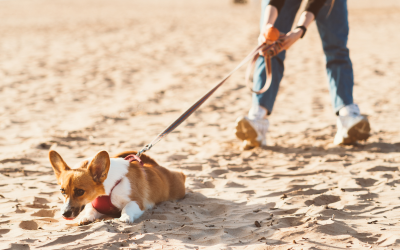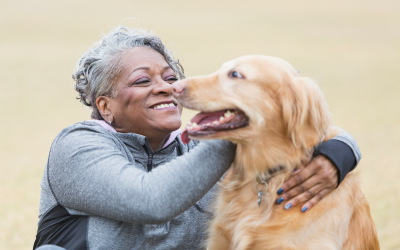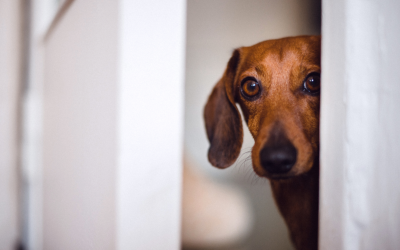A lot of pupper parents are so happy with their dog that they decide to add another four-footer to the mix.
In a lot of cases, this doubles the fun! But unfortunately, that’s not always the case – in some situations, double the dogs means double the trouble, as some pupper pairs just don’t get along well. They may antagonize each other, one may bully the other, or fights may even break out in some cases.
Don’t worry — there are at least seven things you can do to help everyone get along better and restore some harmony to your home. I’ll share them with you below!
Safety First!
Before we get into the specific things you can do to help your dogs get along, it’s important to make sure both of your pets stay safe. If you suspect that your dogs may actually fight while sharing the same space, keep them separated and just skip down to step #7 — getting professional help.
Fights may not only lead to serious injuries, but they can make it more difficult to establish a healthy and peaceful relationship between the puppers over the long run.
1. Understand That Both Dogs Are Individuals

It’s important that you understand that both of your dogs are individuals, with different personalities, energy levels, and triggers. So, invest some time in identifying the important differences between your puppers. This often means spending some one-on-one time playing, training, and walking with each four-footer.
Above all else, try to avoid treating your dogs as a single unit. By treating them as individuals, they’ll be less likely to feel competitive with each other.
2. Establish a Structured Routine

Structure is super important for all canines, and that’s especially true in multi-dog households.
This means establishing regular times for meals, walks, bathroom breaks, and play, and you’ll also want to be clear about the rules regarding things like furniture, toys, and doorway protocols.
By providing your canines with a predictable, consistent routine, you’ll help to alleviate uncertainty and anxiety, which may lead to fights.
3. Manage Their Resources Proactively

Many dogs living in houses with more than one pooch develop resource-guarding issues over time. These can lead to conflicts during meals and possessive behaviors about toys, beds, and even people. So, try to manage the resources that your dogs want or need proactively to keep tension low.
This means picking up high-value chews when you can’t directly supervise your pooch, providing each pupper with their own food and water bowl, and rotating toys regularly, so that both pooches get to play with the super-fun ones.
Even better, try to identify the toys that each doggo likes best, and make sure they each have one they love.
4. Train Your Pups Together and Separately

It’s important to provide plenty of training time for all dogs, as it not only helps them learn skills and understand the way you expect them to behave, but it also provides important mental stimulation.
But when you have more than one dog, you’ll want to train them both separately and together.
Group training sessions help to foster harmony between the woofers and reinforce calm behavior when they’re together. Individual training sessions, on the other hand, help ensure neither dog feels overshadowed, and they also help to strengthen your bond with each of your pets.
5. Supervise Your Pooches Closely

It’s important to supervise your dogs closely when dealing with social tensions, especially when they’re just getting to know each other.
Learn to identify the body language cues that are consistent with healthy play (such as taking turns “winning” and having “loose” body language) and distinguish them from signs of escalating tensions (including hard stares and “stiff” body language).
If you notice that your dogs are getting tense, separate them and redirect their individual attention to something constructive, like a puzzle toy or long-lasting chew.
6. Provide Safe Zones for Both Dogs

All dogs should have a safe place they can retreat to when they’re feeling anxious or overwhelmed, but it is especially important that dogs in multi-pet households have their own, personal retreat.
Crates work wonderfully for this, but a quiet spot in a low-traffic room or open closet can work. If this isn’t possible, you can try to establish safe zones for each pet that are ideally on opposite sides of you. For example, you may place a dog bed beneath the tables at each end of your couch.
Providing dogs with their own individual spaces is especially helpful when dealing with pups with different energy levels (or ages).
7. Seek Professional Help If You Need It

By employing the tips shared above, you’ll likely be able to encourage your pooches to get along well and enjoy some peace and quiet yourself. But not all dogs will warm up to each other quickly or easily — some may remain antagonistic despite your attempts to foster a healthy relationship.
In these cases, you’ll want to reach out to a certified dog trainer – like me!
As a trainer, I’ve learned to notice subtle canine cues that can help me pinpoint some of the traits or habits that are leading to the conflict. After identifying some of the things that are causing the problems, I can help you develop a plan for easing some of this tension. Best of all, we’ll work to ensure that the plan meshes well with your needs and lifestyle.
Head on over to the Cosmic Home & Pet contact page now and start getting the help you need!





Recent Comments